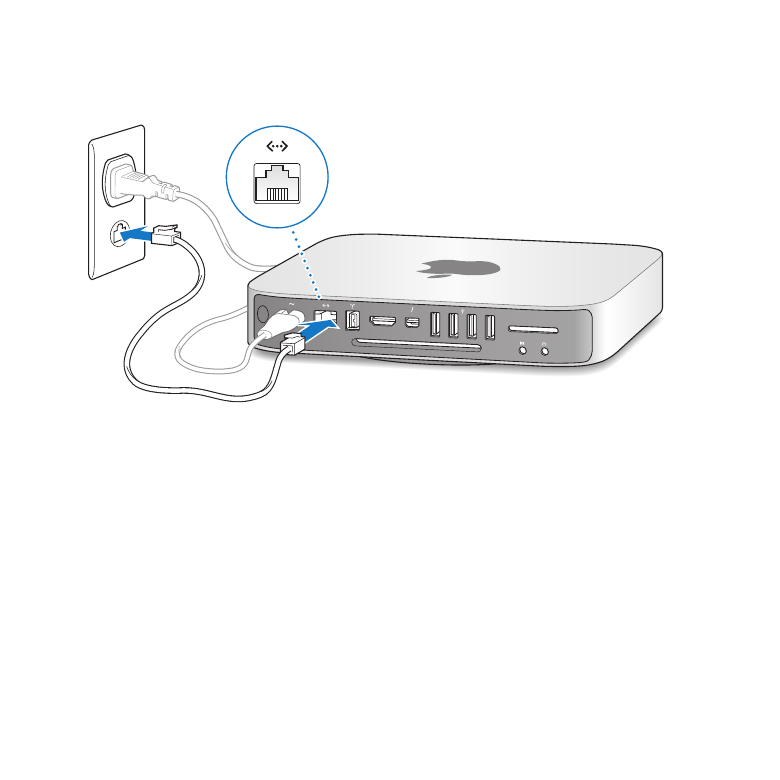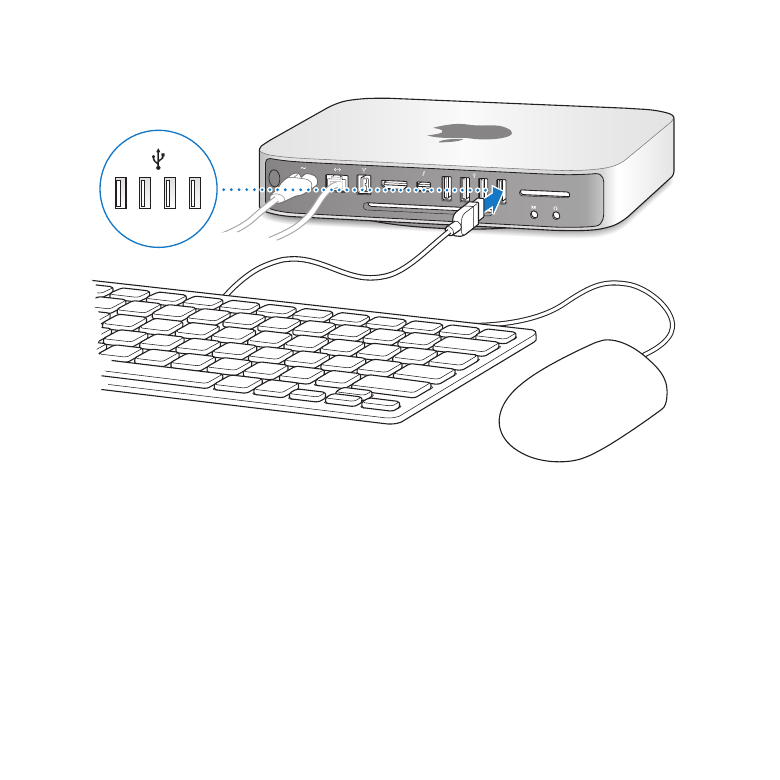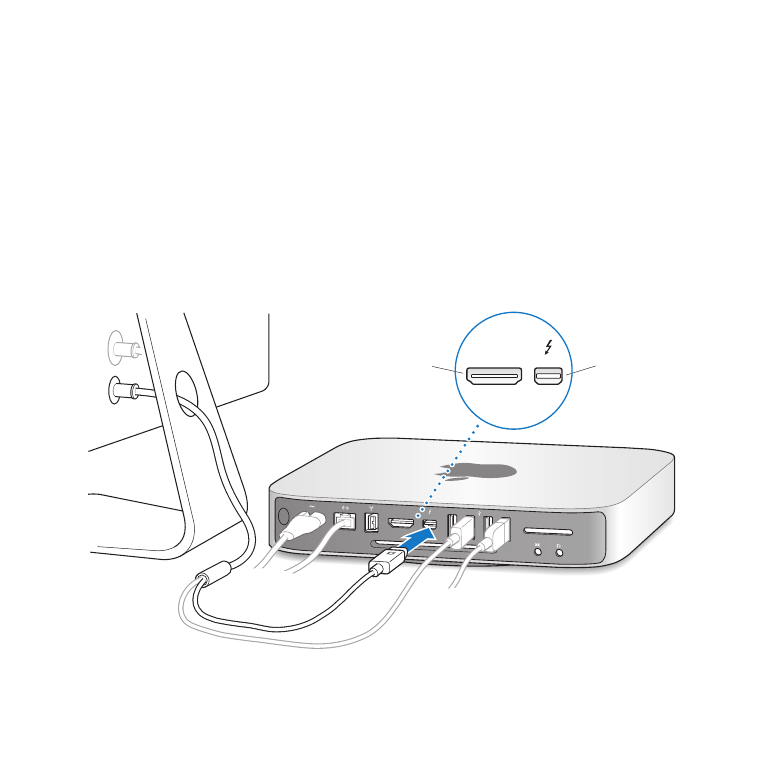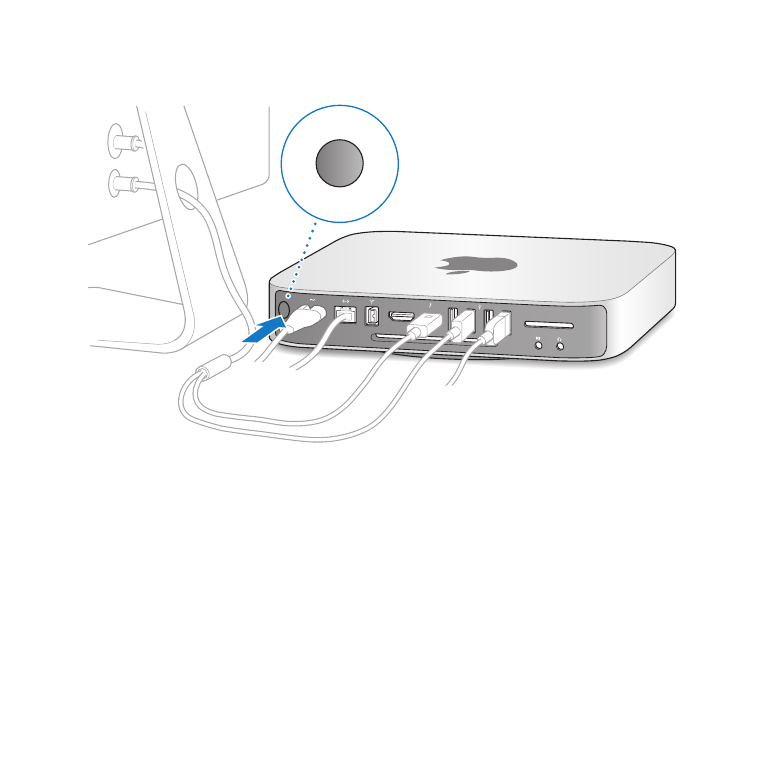
Setting Up Your Mac mini
Place your Mac mini right side up on a firm surface. Use only the power cord that came
with your Mac mini; other power cords may not work.
Important:
Cooling air enters your Mac mini through the gap around the bottom cover
and exits through the vent on the back. Don’t place your Mac mini on a soft surface
(such as a blanket or deep carpet) that interferes with airflow around the bottom cover,
and don’t block the back vent.
Step 1:
Plug the power cord into the back of your Mac mini, and then plug the
other end into a power outlet.
®
HDMI
Exhaust vent
Cool air inlet
(around foot)

12
Chapter 1
Ready, Set Up, Go
Step 2:
To access the Internet or a network, connect one end of an Ethernet cable
to your Mac mini and the other end to a cable modem, DSL modem, or network.
®
HDMI
Your Mac mini comes with AirPort Extreme technology for wireless networking.
For information about setting up a wireless connection, choose Help > Help Center,
and search for “AirPort.”

13
Chapter 1
Ready, Set Up, Go
Step 3:
Connect the USB cable from your keyboard and mouse.
®
HDMI
Your Mac mini doesn’t come with a keyboard or a mouse, but you can use almost any
USB keyboard and mouse. If your keyboard has a USB port (d), plug your mouse into
the USB port on the keyboard. If it doesn’t, plug the mouse into a USB port (d) on the
back of your Mac mini.
Note: If you have Mac OS X Lion Server, you can set it up remotely from another
computer. For information, open the Server application and choose Server Help from
the Help menu.

14
Chapter 1
Ready, Set Up, Go
You can use Keyboard preferences to change the behavior of the Caps Lock, Control,
Option, and Command (x) modifier keys. To open Keyboard preferences, choose
Apple () > System Preferences, click Keyboard, then click Modifier Keys and follow the
onscreen instructions.
If you use a USB keyboard that isn’t specifically designed for the Mac OS, it may not
have a Command (x) or Option modifier key, which are standard on Apple keyboards.
If you have a keyboard from another manufacturer:
Â
The Windows key (the icon on the key looks like a Windows logo) is equivalent to the
Command (x) modifier key on an Apple keyboard.
Â
The Alt key is equivalent to the Option modifier key on an Apple keyboard.
Using a USB mouse or keyboard from another manufacturer may require software
drivers. Check the manufacturer’s website for the latest software drivers.
Using a Wireless Keyboard, Magic Mouse, or Magic Trackpad
If you purchased an Apple Wireless Keyboard, Magic Mouse, or Magic Trackpad with
your Mac mini, follow the instructions that came with the device to set them up with
your Mac mini.

15
Chapter 1
Ready, Set Up, Go
Step 4:
Connect a display cable to the HDMI port or Thunderbolt port.
Your Mac mini doesn’t come with a display, but you can connect a display that has:
Â
A Mini DisplayPort or Thunderbolt connector. Connect directly to the Thunderbolt port.
Â
An HDMI connector. Connect directly to the HDMI port.
Â
A DVI connector. Use the HDMI to DVI Adapter that came with your Mac mini to
connect to the HDMI port.
Â
A VGA connector. Use a Mini DisplayPort to VGA Adapter to connect to the
Thunderbolt port. Adapters are available at www.apple.com/store or your local
Apple Retail Store.
HDMI
port
Thunderbolt
port
®
HDMI
HDMI

16
Chapter 1
Ready, Set Up, Go
Step 5:
Press the power button (®) on the back to turn on your Mac mini.
®
HDMI
®
Step 6:
Configure your Mac mini with Setup Assistant or Server Assistant.
The first time you turn on your Mac mini, Setup Assistant or Server Assistant starts.
Setup Assistant helps you enter your Internet information and set up a user account on
your Mac mini. Continue reading “Setting Up with Setup Assistant” on page 17.
Server Assistant starts up if your Mac mini uses Mac OS X Lion Server. For more
information, see “Setting Up with Server Assistant” on page 19.

17
Chapter 1
Ready, Set Up, Go
Setting Up with Setup Assistant
You can transfer information from another Mac or PC during setup. You can also use
Setup Assistant to transfer information from a Time Machine backup or other disk.
You may have to update software if the other Mac doesn’t have Mac OS X version 10.5.3
or later installed. To migrate from a PC, you need to download Migration Assistant for
Windows from http://apple.com/migrate-to-mac.
After you start Setup Assistant on your Mac mini, you can leave it midprocess without
quitting, move to the other computer if you need to update its software, and then
return to your Mac mini to complete the setup.
If you don’t use Setup Assistant to transfer information when you first start up your
Mac mini, you can do it later using Migration Assistant. Open Migration Assistant in the
Utilities folder in Launchpad. For help using Migration Assistant, open Help Center and
search for “Migration Assistant.”
To set up your Mac mini:
1
In Setup Assistant, follow the onscreen instructions until you get to the “Transfer
Information to This Mac” screen.
2
Do a basic setup, a setup with migration, or transfer information from a Time Machine
backup or other disk:
Â
To do a basic setup, select “Don’t transfer now” and click Continue. Follow the
remaining prompts to select your wireless network, set up an account, and exit
Setup Assistant.

18
Chapter 1
Ready, Set Up, Go
Â
To do a setup with migration, select “From another Mac or PC” and click Continue.
Follow the onscreen instructions to select the Mac or PC you want to migrate
information from. Your Mac or PC must be on the same wired or wireless network.
You can also connect another Mac by using a FireWire cable and then restarting
it in target disk mode. To restart a Mac in target disk mode, restart the computer
while holding down the T key. After selecting your Mac or PC, follow the onscreen
directions for migrating information.
Â
To transfer information from a Time Machine backup or another disk, select “From a
Time Machine backup or other disk” and click Continue. Select the backup or the
other disk that you want to migrate information from and click Continue. Follow the
onscreen directions for transferring the information.
If you don’t intend to keep or use your other computer, it’s best to deauthorize it from
playing music, videos, or audiobooks that you’ve purchased from the iTunes Store.
Deauthorizing a computer prevents any songs, videos, or audiobooks you’ve purchased
from being played by someone else, and frees up another authorization for use. For
information about deauthorizing, choose iTunes Help from the Help menu in iTunes.
After you set up your Mac mini, check for updated software. Choose Apple () >
Software Update from the menu bar and follow the onscreen instructions.

19
Chapter 1
Ready, Set Up, Go
Setting Up with Server Assistant
The first time you turn on your Mac mini with Mac OS X Lion Server installed, Server
Assistant asks for some basic information that Lion Server needs in order to start up
and connect to the network. Be ready to provide the following information the first
time you turn on your Mac mini:
Â
An account name and password
Â
An organizational name that’s unique in your company
Â
A host name, which can be for your local network only, for your local network and
VPN access from the Internet, or an Internet host name you purchased from a domain
name registrar.
Â
Detailed network settings, including IP address, subnet mask, and DNS servers.
The network settings may be provided by your Internet router or a server on your
network. If so, it should be configured to provide your server the same IP address all
the time (static mapping or DHCP reservation).
For help with Server Assistant, click the Help button in any pane.
For help setting up Mac OS X Lion Server remotely on a Mac mini without a keyboard,
mouse, or display, open the Server application and choose Server Help in the Help menu.
If you already have a Mac with Mac OS X Server version 10.5 or later, Server Assistant
can help you automatically transfer system settings, service settings, user accounts, files,
applications, and other information from your previous Mac server (any model) to your
Mac mini. Use an Ethernet, FireWire, or wireless connection to transfer information.
For information about working with the services in Mac OS X Lion Server, open the
Server application and choose Server Help in the Help menu. For more information about
Mac OS X Lion Server, see the Lion Server website at www.apple.com/macosx/server.

20
Chapter 1
Ready, Set Up, Go
Step 7:
Customize your desktop and set your preferences.
You can quickly customize the desktop using System Preferences. Choose Apple () >
System Preferences from the menu bar, or click the System Preferences icon in the
Dock. For more information, open Help Center and search for “System Preferences” or
for the specific preference you want to change.
Important:
You can set an option in Users & Groups preferences to help you reset
your login password if you forget it. You should set your password preferences soon
after setup.